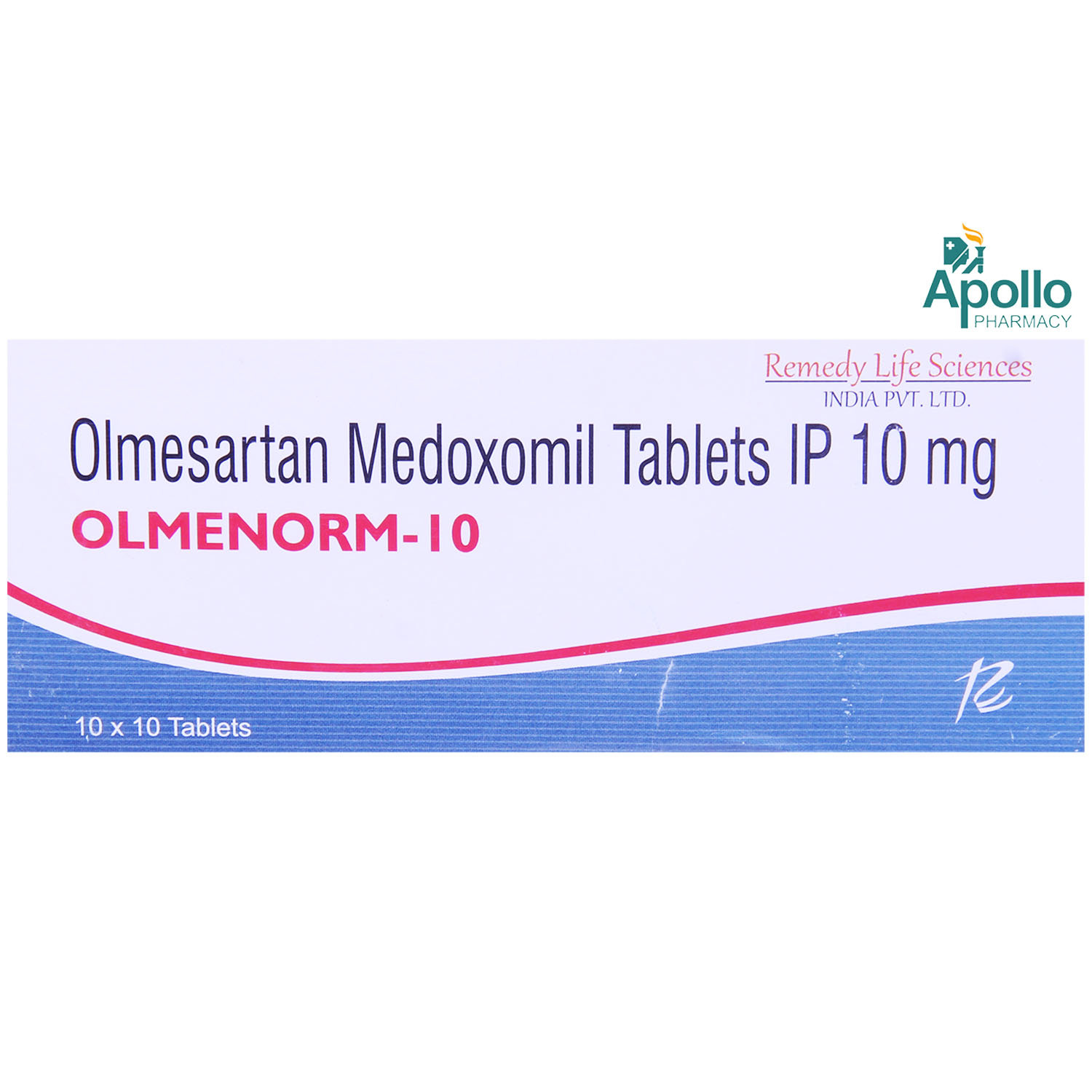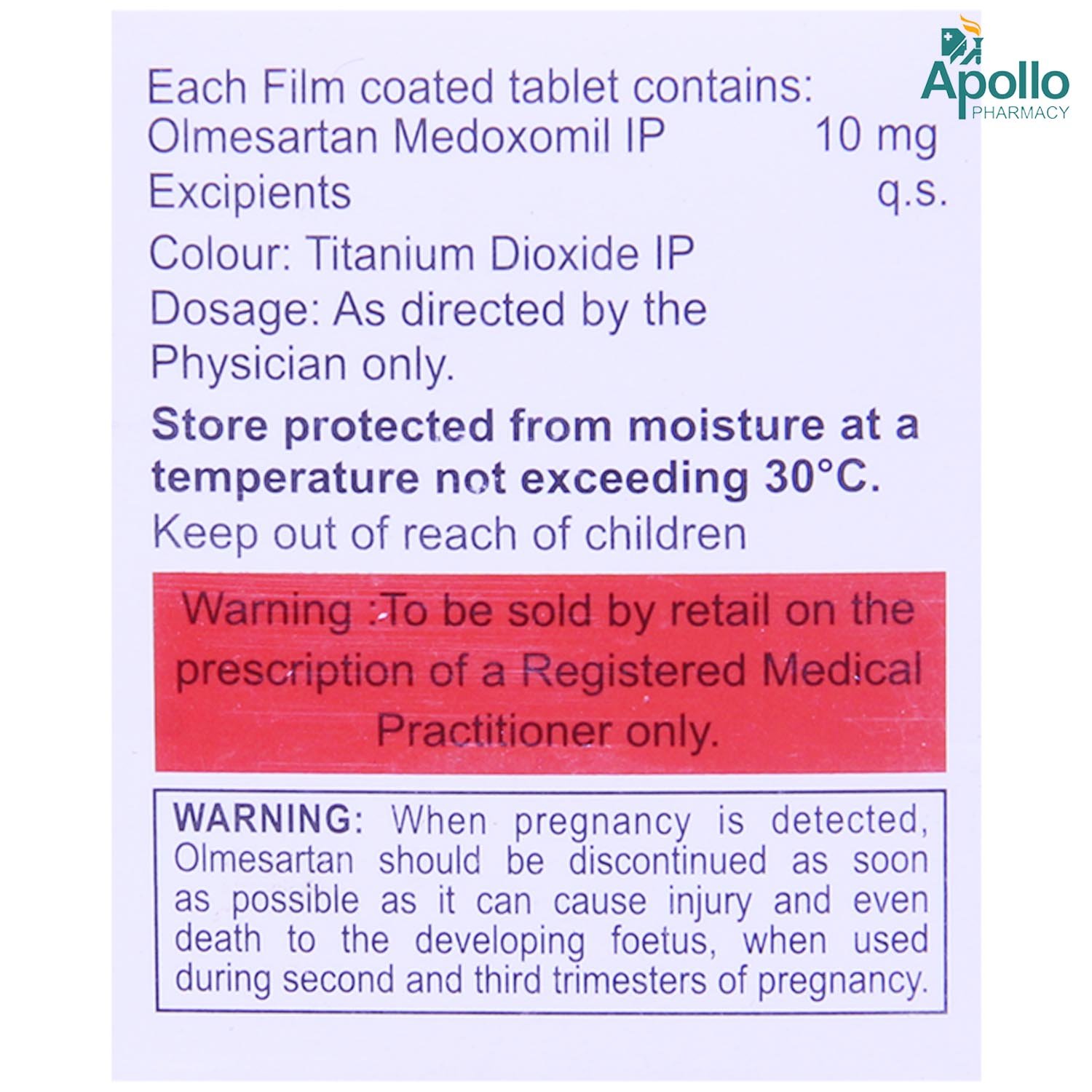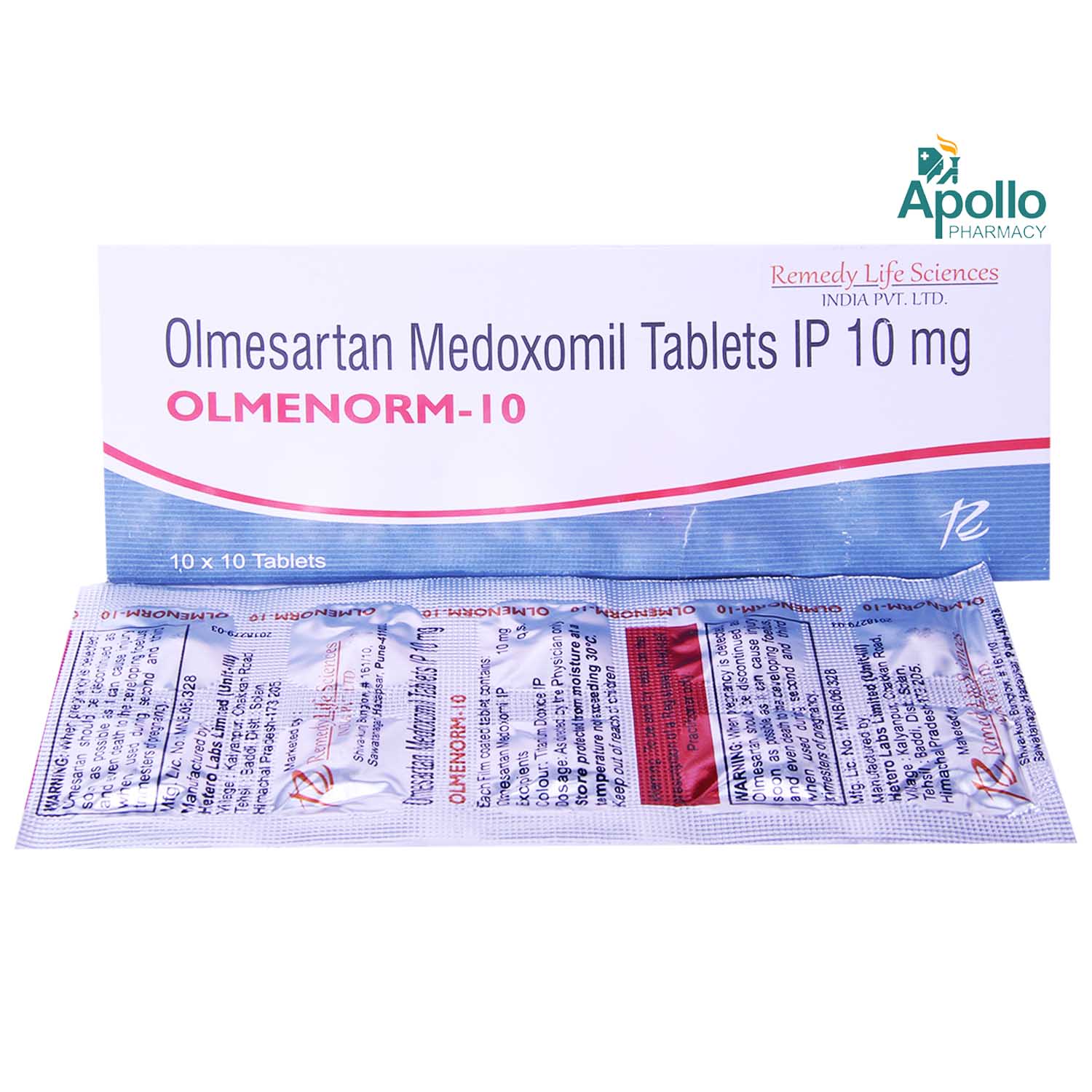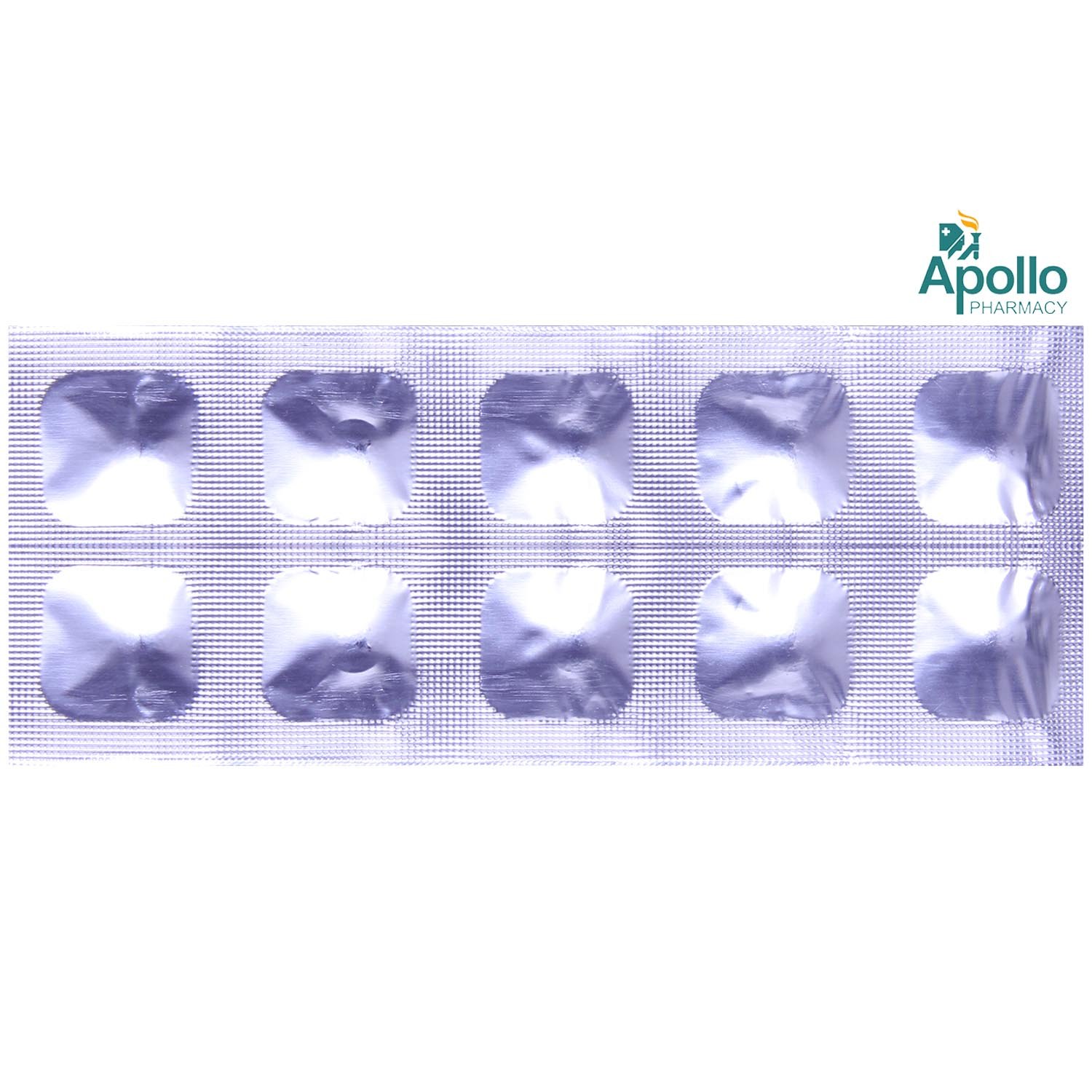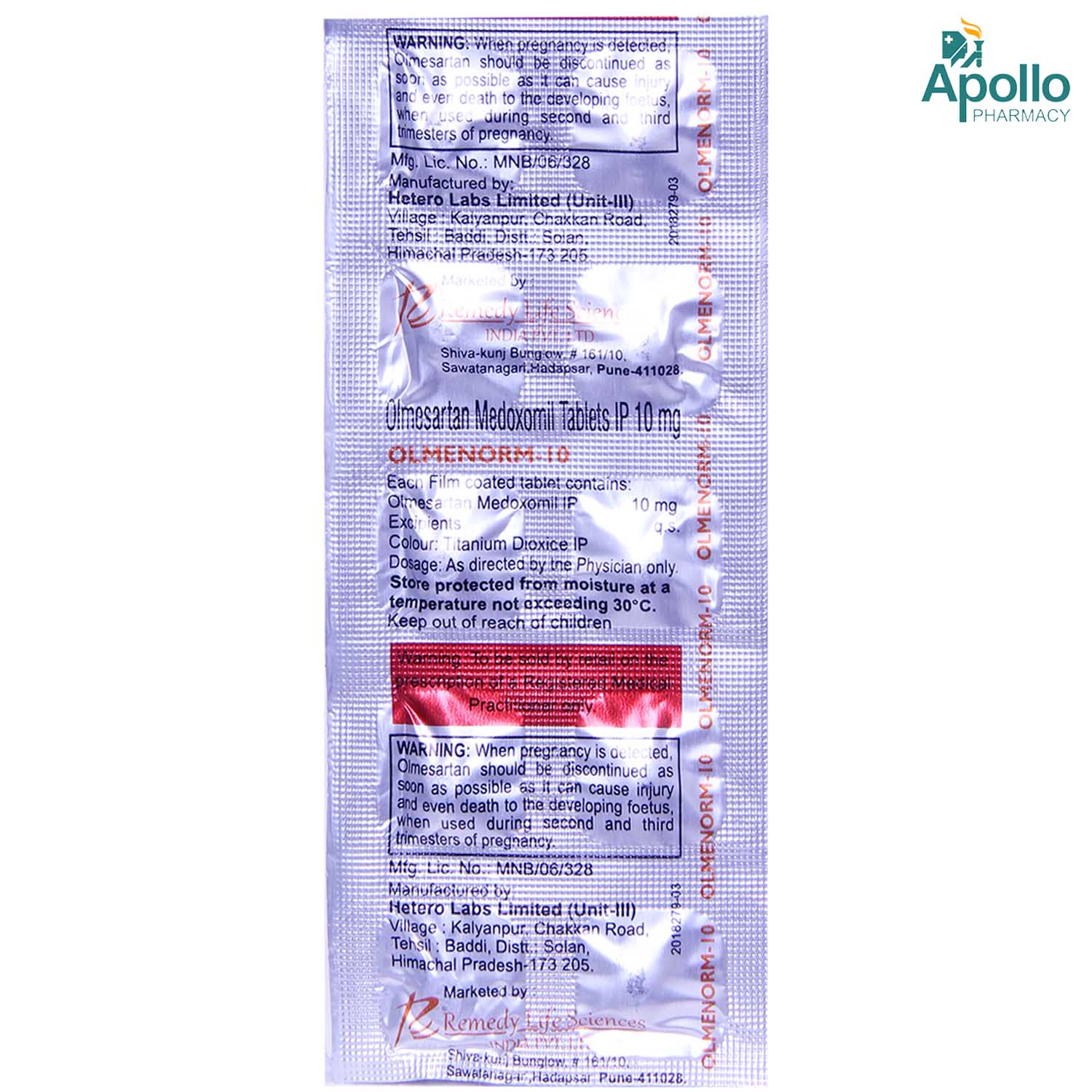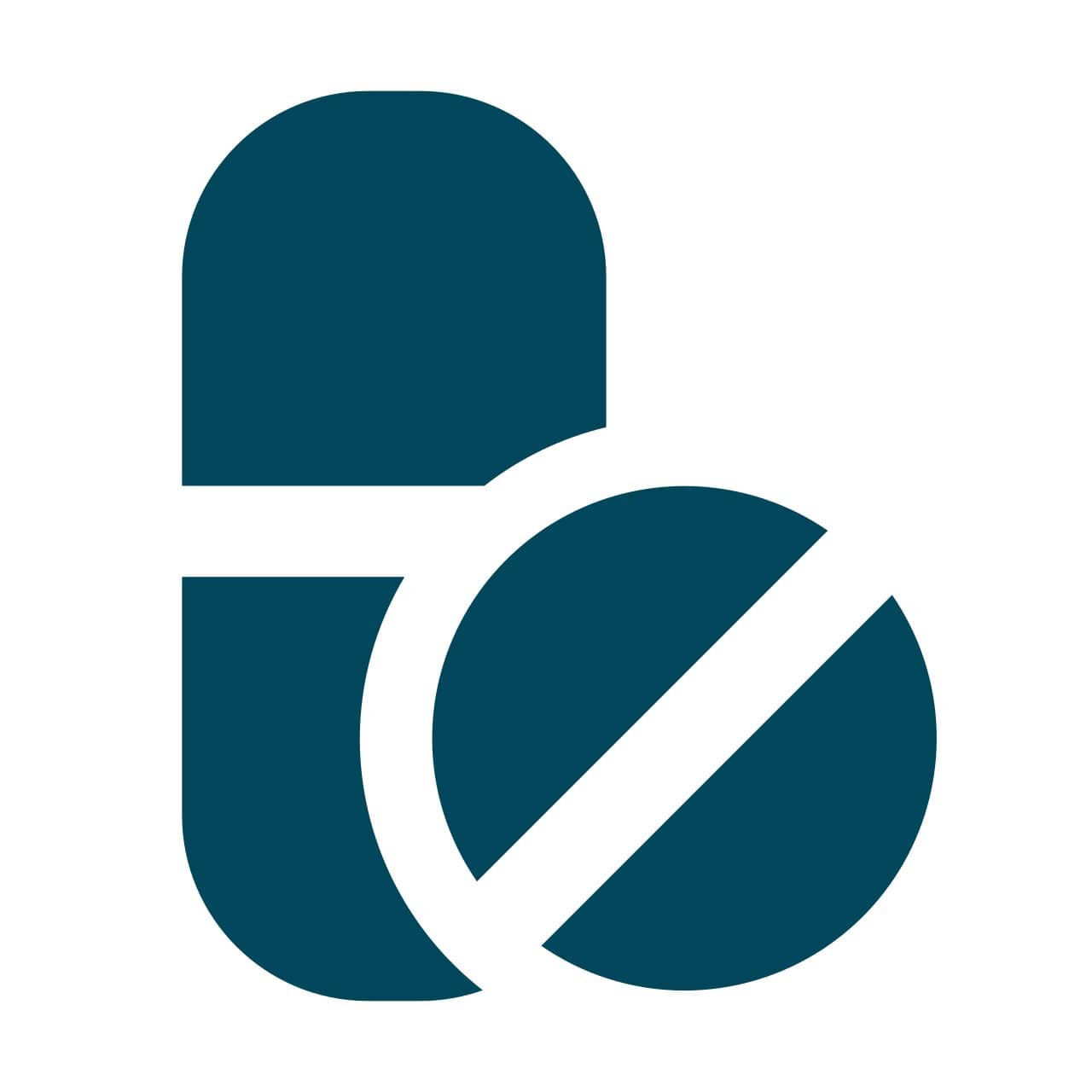Olmenorm 10mg Tablet 10's
MRP ₹69
(Inclusive of all Taxes)
₹10.3 Cashback (15%)
Provide Delivery Location
Online payment accepted
 Prescription drug
Prescription drugWhats That
 11 people bought
11 people bought Composition :
Manufacturer/Marketer :
Consume Type :
Expires on or after :
Return Policy :
About Olmenorm 10mg Tablet
Olmenorm 10mg Tablet belongs to a group of medicines called angiotensin II receptor antagonists that are used for the treatment of hypertension (high blood pressure). Additionally, Olmenorm 10mg Tablet is used to reduce the risk of heart attack or stroke and kidney problems. Hypertension is a medical condition, in which the blood exerts high blood pressure against the walls of the blood vessels. Due to this, the heart has to work harder to pump the supply of blood in the whole body. On the other hand, heart attack or stroke occurs due to blocked blood flow to the heart or brain, respectively.
Olmenorm 10mg Tablet contains Olmesartan, and it is only available on prescription. It is an angiotensin receptor blocker (ARB). It works by blocking the hormone angiotensin, thereby relaxing blood vessels. This allows the blood to flow more smoothly and the heart to pump more efficiently.
You can take Olmenorm 10mg Tablet with or without food as prescribed by your doctor. It should be swallowed whole with a glass of water. Your doctor will advise you how often you take your tablets based on your medical conditions. You may experience dizziness, headache, nausea, indigestion, diarrhoea, stomach ache, gastroenteritis, upper respiratory infections in more cases. Most of these side effects of Olmenorm 10mg Tablet do not require medical attention and gradually resolve over time. However, if the side effects are persistent, reach out to your doctor.
Do not use potassium supplements or salt substitutes unless your doctor has told you. Olmenorm 10mg Tablet is not for pregnant women as its use during your pregnancy can cause injury and even death to your unborn baby. It is not known whether Olmenorm 10mg Tablet passes into breast milk or not. Please consult your doctor, and your doctor will decide if you will take Olmenorm 10mg Tablet while using Olmenorm 10mg Tablet breastfeeding together. Do not consume alcohol with Olmenorm 10mg Tablet as it may increase the risk of low blood pressure.
Uses of Olmenorm 10mg Tablet
Directions for Use
Key Benefits
Olmenorm 10mg Tablet is an angiotensin II receptor antagonist that blocks the action of a hormone called angiotensin I in the body that causes narrowing of blood vessels leading to high blood pressure-lowering high blood pressure by widening and relaxing blood vessels. Olmenorm 10mg Tablet is used to treat high blood pressure and reduce the risk of heart attack or stroke. This medicine needs to be taken regularly to be effective.
Storage
Drug Warnings
Olmenorm 10mg Tablet is not recommended for people who have allergic with Olmenorm 10mg Tablet have impaired kidney function, diabetes, liver problems, pregnant women, or planning to get pregnant and breastfeeding women. Olmenorm 10mg Tablet may increase the risk of low blood pressure when taken with alcohol. Besides this, it is contraindicated in low blood pressure (hypotension), cardiogenic shock (sudden stopping of blood flow to the heart), and aortic stenosis (heart valve problem). Avoid intake of potassium supplements with Olmenorm 10mg Tablet as it may lead to high potassium levels in the blood, so the doctor may ask you to have a regular check of your potassium level. Taking Olmenorm 10mg Tablet with painkillers can increase the risk of kidney problems and reduces the efficacy of Olmenorm 10mg Tablet .
Diet & Lifestyle Advise
- Keep your weight under control with BMI 19.5-24.9.
- Limit intake of sodium chloride (table salt) in your daily diet and minimize eating processed foods as they contain more sodium. Try to replace salt with spices or herbs to add flavour to the food.
- Monitor your blood pressure daily and if there is too much fluctuation, then immediately contact your doctor.
- Try to include heart-healthy omega-3 fatty acids containing food drinks in your daily diet. You can also use low-fat cooking oil like olive oil, soybean oil, canola oil, and coconut oil to lower your elevated blood.
- Chronic stress may also cause high blood pressure. Therefore, avoid stress by chain your expectations, the way you react in certain situations, and making time for yourself to do activities that you enjoy.
- Do regular exercise for at least 150 minutes per week, or about 30 minutes most days of the week. Doing this can help you to lower your raised blood pressure by about 5 mm of Hg.
- Quitting smoking is the best strategy to lower the risk of heart disease.
Side Effects of Olmenorm 10mg Tablet
- Dizziness
- Headache
- Nausea
- Indigestion
- Diarrhea
- Stomach pain
- Tiredness
- Sore throat
- Runny or stuffy nose
- Flu-like symptoms
Habit Forming
Therapeutic Class
All Substitutes & Brand Comparisons
RX
Olmetop 10 mg Tablet 10's
Elbrit Life Sciences Pvt Ltd
₹61.5
(₹5.54 per unit)
10% CHEAPER
Author Details
We provide you with authentic, trustworthy and relevant information
FAQs
Drug-Drug Interactions Checker List
- ALISKIREN
- ENALAPRIL
- CAPTOPRIL
- IBUPROFEN
- NAPROXEN
- DICLOFENAC
- AMILORIDE+HYDROCHLOROTHIAZIDE
- BUMETANIDE
- FUROSEMIDE
- CELECOXIB
- ETORICOXIB
- LITHIUM
- HEPARIN
- SPIRONOLACTONE
- ASPIRIN
Special Advise
- Monitor your blood pressure regularly and if you notice any fluctuations, please consult your doctor.
- A low salt diet and regular exercise are recommended along with Olmenorm 10mg Tablet for effective results.
Disease/Condition Glossary
Hypertension: It is a chronic condition when blood pressure is too high. Blood pressure is defined as the amount of blood pumped by the heart and the amount of resistance exerted by the arteries against the blood flow. If the heart pumps more blood then arteries become narrower and in turn blood pressure becomes high. If blood pressure becomes uncontrolled, then it may cause serious heart disease including stroke and heart attack. Additionally, high blood pressure also causes brain damage (stroke), and kidney failure. Blood pressure is expressed by systolic and diastolic. Systolic blood pressure represents the contraction and relaxation of the heart. Diastolic represents the pressure in the vessels when the heart beats and in a resting state. Ideal blood pressure should be between 90/60mmHg and 120/80mmHg. Hypertension is detected when systolic blood pressure is more than 140mmHg and diastolic pressure is higher than 90mmHg. Some of the symptoms of hypertension include headache, nose bleed, vomiting, and chest pain.

Have a query?
Alcohol
Safe if prescribed
You are recommended to avoid consumption of alcohol while taking Olmenorm 10mg Tablet as it may increase the risk of low blood pressure and cause adverse effects such as dizziness, fainting, light-headedness, or headache.
Pregnancy
Consult your doctor
Olmenorm 10mg Tablet is unsafe to use during pregnancy since it affects the fetus. Please consult your doctor if you are planning to become pregnant or already pregnant before starting Olmenorm 10mg Tablet .
Breast Feeding
Consult your doctor
The safe use of Olmenorm 10mg Tablet in breastfeeding mothers has not yet been established. So, it should be used in breastfeeding women only when prescribed by a doctor.
Driving
Safe if prescribed
Olmenorm 10mg Tablet may cause dizziness or tiredness in some people. So, make sure you are not affected before driving or operating machinery.
Liver
Consult your doctor
Take Olmenorm 10mg Tablet with caution, especially if you have a history of liver diseases/conditions. The dose may be adjusted by your doctor as required. Olmenorm 10mg Tablet is not recommended for patients with severe liver disease.
Kidney
Consult your doctor
Take Olmenorm 10mg Tablet with caution, especially if you have a history of kidney diseases/conditions. The dose may be adjusted by your doctor as required. Olmenorm 10mg Tablet is not recommended for patients with severe kidney disease.
Children
Safe if prescribed
Olmenorm 10mg Tablet is not recommended for children below 6 years as the safety and effectiveness in children not established.

